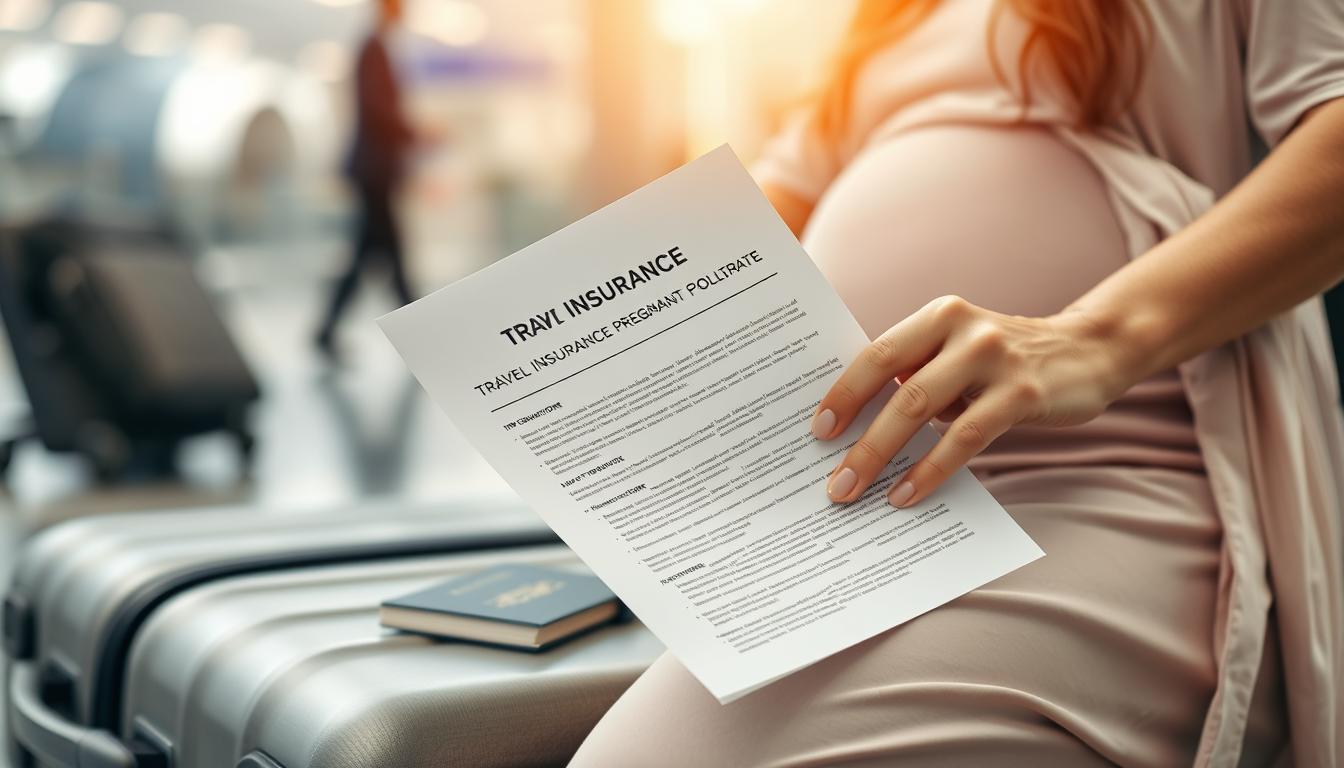Planning a trip while expecting? You’re not alone—many adventurers explore new destinations during pregnancy. But what happens if unexpected complications arise? That’s where specialized coverage steps in. Protection designed for expecting mothers can ease worries by addressing emergencies, though standard policies often exclude routine prenatal care.
Providers like Allianz Global Assistance offer tailored plans with clear guidelines. Always consult your doctor first—they’ll help determine if your journey aligns with health recommendations. Understanding policy details prevents surprises, like knowing whether preterm labor or sudden cancellations qualify for reimbursement.
In this guide, we’ll break down how coverage during pregnancy works, what to prioritize, and how to choose wisely. Whether you’re booking a babymoon or a business trip, you’ll gain the clarity needed to explore confidently. Let’s ensure your next adventure stays safe and memorable.
Travel Insurance for Pregnant Travelers: An Overview
Exploring new destinations while expecting requires thoughtful preparation. Specialized coverage acts as a safety net, addressing scenarios standard plans often overlook. This protection focuses on unexpected events rather than routine prenatal care, giving you peace of mind to enjoy your journey.
Defining Coverage in the Context of Pregnancy
Most policies only address complications, like preterm labor or gestational diabetes. For example, Allianz Global Assistance requires physician certification to confirm medical necessity for cancellations. Always check due date restrictions—many providers limit coverage after 32 weeks. Early trips during the first trimester may also need extra documentation since risks are higher.
Service Focus and Key Advantages
This type of plan prioritizes clarity. You’ll know exactly what’s covered, from emergency hospital stays to trip interruptions caused by sudden issues. Nonrefundable expenses like flights or hotels often qualify for reimbursement if complications arise. Keep policy documents accessible and review requirements for medical proof before departure. Transparent terms help you make informed decisions without second-guessing.
Why Travel Insurance for Pregnant Women is Essential
Expecting a child shouldn’t mean canceling your wanderlust, but smart safeguards are non-negotiable. Even smooth pregnancies can take unexpected turns, turning dream trips into stressful situations. Specialized plans act as a lifeline, covering costs tied to sudden health shifts or disrupted itineraries.
Protection Against Unforeseen Pregnancy Complications
Medical emergencies don’t announce themselves. Conditions like pre-eclampsia or gestational diabetes can develop rapidly, requiring immediate care. For instance, hyperemesis gravidarum—severe nausea—might force hospitalization abroad. Without coverage, bills could skyrocket.
| Coverage Trigger | Example Scenario | Required Proof |
|---|---|---|
| Hospitalization | Preterm labor requiring bed rest | Doctor’s diagnosis |
| Trip Cancellation | Placental abruption before departure | Physician’s written advice |
| Emergency Evacuation | High-risk diagnosis mid-trip | Medical facility records |
Ensuring Medical and Trip Cancellation Coverage
Plans like Allianz reimburse nonrefundable costs if a doctor confirms travel isn’t safe. Always carry policy details and know claim deadlines. Peace of mind comes from understanding exactly what’s included—so review terms before booking flights or hotels.
Key takeaway? Prioritize plans that align with your due date and destination risks. A quick call to your healthcare provider ensures you’re never caught off guard.
Understanding Pregnancy-Related Coverage
Navigating coverage during pregnancy can feel overwhelming, but knowing what to expect simplifies decisions. Specialized plans focus on urgent scenarios rather than everyday needs, creating a clear boundary between emergencies and routine care. Let’s break down what’s included—and what might surprise you.
Included Medical Emergencies and Hospitalization
Most policies cover pregnancy-related crises requiring immediate treatment. Think preterm contractions, placental issues, or sudden high blood pressure. Here’s what’s typically included:
- Emergency hospital stays for complications like pre-eclampsia
- Medically necessary evacuations to ensure proper care
- Diagnostic tests linked to unexpected symptoms
For example, if gestational diabetes leads to hospitalization abroad, your plan may reimburse costs. Always confirm coverage timelines—some exclude claims after 32 weeks.
Coverage Limits and Exclusions
Standard prenatal checkups or planned deliveries rarely qualify. Morning sickness without severe dehydration? Likely excluded. See how common scenarios compare:
| Covered | Not Covered |
|---|---|
| Emergency C-section | Routine ultrasounds |
| Preterm labor care | Normal childbirth |
| Medically ordered bed rest | Elective itinerary changes |
We recommend scanning your policy documents for phrases like “high-risk” or “acute onset.” Some plans add fees for pre-existing conditions. When in doubt, ask providers to clarify exclusions in writing before departure.
Navigating Trip Cancellations and Interruptions
Unexpected changes can disrupt even the best-laid plans, especially when expecting. Knowing how to manage cancellations or mid-trip halts due to complications ensures you’re prepared for the unpredictable. Let’s simplify the steps to secure reimbursement while minimizing stress.
Guidelines for Claiming Due to Complications
Start by notifying your provider immediately if a health issue forces itinerary changes. For example, Allianz requires claims to include:
| Step | Action | Timeframe |
|---|---|---|
| 1 | Submit claim form | Within 20–90 days |
| 2 | Attach doctor’s note | Before departure date |
| 3 | Provide receipts | With initial submission |
Common qualifying scenarios include preterm labor, pre-eclampsia, or placental abruption. Delays in reporting often lead to denied claims—act quickly to meet deadlines.
Documentation and Physician’s Confirmation
A signed statement from your healthcare provider is non-negotiable. It must confirm the complication prevented safe travel. Keep copies of:
- Medical records linking the issue to cancellation
- Nonrefundable booking confirmations
- Policy number and contact details
One traveler successfully claimed after gestational hypertension led to bed rest—their timely submission and clear doctor’s note sped up reimbursement. Always double-check your how to file a claim process to avoid missing critical steps.
Pro tip: Save digital and physical copies of all documents. Early communication with your insurer resolves most issues before they escalate.
Airline and Destination Considerations
Flying while expecting requires more than just packing snacks—it demands awareness of airline policies and destination readiness. Rules vary widely between carriers, and health standards at your chosen spot could impact your plans. Let’s simplify what you need to know before booking.
Specific Airline Rules for Pregnant Travelers
Major U.S. carriers enforce different cutoff dates for expecting passengers. For example:
| Airline | Cutoff Week | Required Documentation |
|---|---|---|
| American Airlines | After 36 weeks | Doctor’s note post-28 weeks |
| Delta | No restrictions | Medical form if complications arise |
| United | After 36 weeks | Certificate dated within 3 days |
Always confirm policies directly—some restrictions apply earlier for international flights. Carriers may deny boarding if you’re too close to your due date without proper paperwork.
Destination Health Standards and Vaccination Needs
Your dream location might require vaccines unsafe during pregnancy, like yellow fever. Check CDC guidelines and local hospital ratings. For example, Zika-prone areas remain risky despite lower transmission rates.
Three steps to stay prepared:
- Verify entry requirements for maternal health services
- Pack copies of prenatal records for emergencies
- Research nearby clinics with OB/GYN support
Family itineraries should include backup plans if sudden rule changes occur. A quick call to your airline and a review of State Department advisories keeps surprises at bay.
Managing Medical Emergencies and Pre-Existing Conditions
When health concerns arise far from home, knowing your coverage details becomes crucial. Specialized plans prioritize urgent scenarios, ensuring you receive proper care without draining savings. Let’s unpack how evacuation services and pre-existing condition protocols work together to protect you.

Emergency Medical Evacuation Benefits
Imagine experiencing preterm contractions in a remote area. Evacuation coverage arranges transport to the nearest facility equipped for high-risk care. Providers like Allianz coordinate flights, ambulances, and medical escorts—often covering 100% of costs if deemed necessary.
Key steps to activate this benefit:
- Contact your insurer immediately after a diagnosis
- Provide proof of medical necessity from local doctors
- Follow their approved evacuation partners to avoid out-of-pocket fees
One traveler avoided $50,000 in air ambulance costs when placental abruption required emergency relocation. Always keep your policy number handy—speed matters in crises.
Addressing Pre-Existing Conditions and Risk Factors
Disclosing health history prevents claim denials. For example, a history of blood clots (DVT) might require additional documentation. Most plans exclude conditions not reported during application.
| Scenario | Coverage Outcome |
|---|---|
| Disclosed chronic hypertension | Covered if stable pre-departure |
| Undisclosed prior preterm birth | Likely denied |
We recommend reviewing terms for phrases like “stable period”—some require 60–180 days without treatment changes. A quick call to your provider clarifies gray areas. Pro tip: Schedule a pre-travel consultation if you’ve had pregnancy complications before—it strengthens your case if claims arise.
Planning and Preparing for Mom-to-Be Travel
Smart preparation transforms your journey from stressful to serene. Focus on aligning your itinerary with medical recommendations while prioritizing comfort. A little foresight goes a long way in safeguarding both you and your little one.
Pre-Travel Consultations and Doctor’s Advice
Book a checkup before finalizing plans. Your healthcare provider will assess risks based on due dates, destination health standards, and personal history. Key discussion points often include:
- Approval for specific activities or climates
- Vaccination safety updates (e.g., flu shots vs. live-virus options)
- Blood pressure checks and fetal monitoring
One traveler shared how her doctor advised against high-altitude destinations due to anemia risks—a detail she hadn’t considered. Always request a signed health clearance for insurance requirements.
Health and Comfort Preparations
Pack like a pro with these essentials:
- Compression socks to boost circulation during flights
- Hydration packets and nausea-relief snacks
- Copies of prenatal records in digital and physical formats
Build rest days into your schedule and research hospitals near accommodations. If exploring European cities, prioritize hotels with elevators over fifth-floor walk-ups. Comfort isn’t just luxury—it’s strategic planning for your well-being.
Documenting Your Pregnancy for Insurance Claims
Proper documentation is your strongest ally when unexpected situations arise. Clear records create a roadmap for smooth claims processing, reducing delays and frustration. Let’s simplify how to prepare your paperwork like a pro.
Gathering Policy Documents and Medical Records
Start by organizing these essentials:
- Policy numbers and coverage summaries
- Dated physician notes confirming medical restrictions
- Receipts for nonrefundable bookings
- Test results linked to complications
Digital tools like cloud storage apps keep files accessible. Pair them with a physical folder for backup. Providers like Allianz Global Assistance often require proof within 30 days—timely submissions prevent denied claims.
Double-check that all information matches your current status. An outdated due date or incorrect policy number can derail approvals. One traveler shared how color-coding her files helped resolve a dispute in under 48 hours.
Finally, review requirements with your healthcare team. They’ll ensure medical records include precise details insurers need. With everything in order, you’ll navigate claims confidently—no last-minute scrambles required.
Special Cases: Late-Term and Surprise Pregnancies
What if your plans shift unexpectedly due to a pregnancy surprise? Coverage varies dramatically depending on timing. Policies often treat late-term scenarios differently than early-stage discoveries, so understanding these distinctions keeps you prepared.
Differences in Coverage Based on Pregnancy Stage
Most providers limit eligibility after 32 weeks. For example, Allianz excludes claims linked to due dates within 8 weeks of departure. AXA similarly denies coverage for hospitalizations deemed “preventable” in later stages. Early pregnancies face stricter scrutiny too—undisclosed first-trimester trips might void claims if complications arise.
Compare how two common scenarios play out:
| Scenario | Coverage Outcome |
|---|---|
| Booking at 20 weeks, canceling at 34 | Excluded (post-cutoff) |
| Discovering pregnancy post-purchase | Possible partial refund |
When Pregnancy is Discovered After Purchase
Found out after booking? Notify your provider immediately. Some plans allow adding coverage if you’re still within the “free look” period—usually 10–15 days. However, trip cancellation due to morning sickness might not qualify unless deemed high-risk.
One traveler learned this the hard way: her insurer denied a claim because she waited 3 weeks to report her new due date. Always check policy timelines for updates. Pro tip: Ask providers like AXA about “change of circumstance” clauses—they sometimes offer flexibility.
Key takeaway: Review terms before finalizing plans. Advanced stages carry higher risks, and last-minute surprises rarely qualify for reimbursement. Stay ahead by communicating changes swiftly and documenting every step.
Health and Safety Tips for Expecting Travelers
Staying healthy while exploring new places requires smart strategies tailored to your changing needs. Simple adjustments can reduce risks and keep you comfortable, letting you focus on making memories. Let’s explore practical ways to stay safe and energized.
Preventing Deep Vein Thrombosis and Staying Hydrated
Long journeys increase circulation risks, but proactive steps help. Wear medical-grade compression socks during flights or car rides—they improve blood flow and reduce swelling. Stand up every hour to stretch your legs, even if it’s just a quick walk down the aisle.
Hydration combats fatigue and morning sickness. Sip water throughout the day, aiming for 8–10 ounces hourly. Pack electrolyte packets for added balance, especially in warm climates. Snack on ginger candies or crackers if nausea strikes unexpectedly.
| Prevention Method | How It Helps | Frequency |
|---|---|---|
| Compression Socks | Boosts circulation | Wear during travel |
| Leg Exercises | Reduces clot risk | Every 60–90 minutes |
| Hydration | Fights dizziness | 8–10 oz/hour |
Comfort and Safety Measures During Travel
Choose aisle seats for easy bathroom access and movement. Loose, breathable clothing prevents overheating—layer a light cardigan for temperature shifts. Schedule breaks every 2–3 hours during road trips to stretch and refresh.
Address common questions by planning ahead: Can you adjust activities if fatigue hits? Yes! Build flexible downtime into each day. Keep snacks like almonds or apple slices handy for quick energy boosts. Prioritize rest—your body will thank you later.
Policy Limitations and Exclusions to Note
Understanding the fine print in your coverage is crucial—many situations you assume are protected might not be. Policies often have strict rules about what qualifies for reimbursement, especially when it comes to maternal health.
Understanding What Is Not Covered
Normal pregnancies rarely qualify for claims. Most plans exclude routine care like checkups or ultrasounds. For example, standard childbirth without complications typically isn’t covered, even if it occurs earlier than expected.
Common exclusions include:
| Covered | Not Covered |
|---|---|
| Emergency C-sections | Planned deliveries |
| Preterm labor treatment | Morning sickness (mild) |
| Hospitalization for pre-eclampsia | Elective itinerary changes |
Restrictions vary widely between providers. Some deny claims after 32 weeks, while others require pre-approval for high-risk conditions. Always ask specific questions about gestational age cutoffs and documentation needs.
We recommend reviewing policy documents for phrases like “elective procedures” or “routine care.” If your plan mentions riders, check whether they expand coverage for prenatal scenarios. A quick call to your provider clarifies gray areas—don’t wait until you need to file a claim.
Key takeaway? Compare multiple policies side-by-side. Look for transparency around exclusions and confirmation that your due date aligns with their terms. A little extra research now prevents financial surprises later.
Conclusion
Creating memories before your baby arrives is possible with smart planning. Tailored protection offers peace of mind by addressing sudden complications and unexpected cancellations. While no plan covers every scenario, the right policy acts as a safety net for critical moments.
Always review documents thoroughly—knowing coverage limits prevents surprises. Partner with your doctor to align trips with medical advice, and keep health records accessible. Proper preparation reduces risks, letting you embrace adventures confidently.
Though not all-encompassing, this protection empowers you to navigate emergencies without financial stress. Ready to explore? Review your itinerary, compare plans, and prioritize coverage that matches your needs.
Questions? Our team is here to help you craft worry-free journeys. With the right safeguards, every step becomes part of your story—even during this extraordinary chapter.


